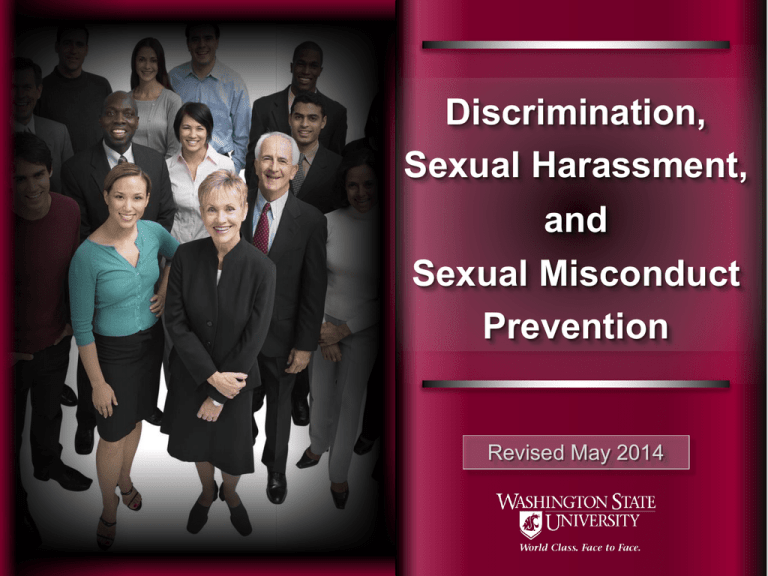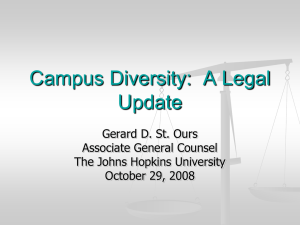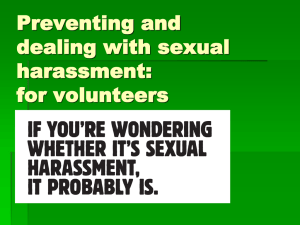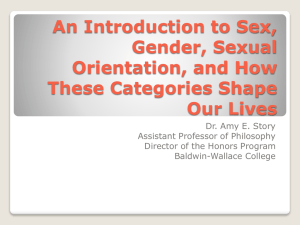
Discrimination,
Sexual Harassment,
and
Sexual Misconduct
Prevention
Revised May 2014
Disclaimer
This program is for instructional purposes only and
is not to be regarded as legal advice.
The scenarios and situations described in the
course have been fabricated for the purpose of
illustrating specific learning objectives and are not
intended as categorical evidence of discrimination,
sexual harassment or sexual misconduct.
All allegations of discrimination, sexual
harassment, and/or sexual misconduct require
careful analysis and thorough investigation.
Course Objectives
1) Identify specific University policies
2) Identify issues that implicate discrimination,
sexual harassment, and sexual misconduct
3) Describe your responsibilities as an employee
and supervisor
4) Identify specific University offices and resources
to assist in cases of alleged discrimination,
sexual harassment, and sexual misconduct
OFFICE OF THE
PRESIDENT
April 12, 2010
Eradicating discrimination and sexual
harassment and fostering a respectful
environment requires an ongoing,
demonstrated commitment from all
members of the University community.
Elson S. Floyd, Ph.D.
President
Washington State University
OFFICE OF THE
PRESIDENT
April 12, 2010
All supervisors are expected to reflect this
responsibility in all aspects of their conduct.
Make it clear to your employees that you will
not tolerate sexual or discriminatory
remarks, jokes or behavior in the
workplace.
Elson S. Floyd, Ph.D.
President
Washington State University
Federal/State Laws
In addition to WSU’s commitment to diversity
and creating an environment free from
discrimination, sexual harassment, and sexual
misconduct, WSU must comply with various
federal and state laws regarding
discrimination (e.g. 14th Amendment, ADA,
ADEA, Title VII, Title IX, RCW 49.60, etc.).
WSU Policy
Executive Policy #15:
WSU Policy Prohibiting
Discrimination, Sexual Harassment,
& Sexual Misconduct
Executive Policy #28:
WSU Policy on
Faculty-Student and
Supervisor-Subordinate
Relationships
EP #15:
WSU Policy Prohibiting
Discrimination, Sexual Harassment,
and Sexual Misconduct
This policy expresses the commitment of
WSU to maintaining an environment free
from all forms of discrimination, including
discriminatory harassment, sexual
harassment, and sexual misconduct.
This policy applies to all students, faculty,
staff, or others having an association with
the University.
EP #15:
Discrimination Prohibited
It specifically prohibits discrimination on the
basis of:
• Race;
• Sex/Gender;
• Sexual Orientation;
• Gender Identity/Expression;
• Religion;
• Age;
• Color;
• Creed;
• National or Ethnic Origin;
• Physical, mental or sensory
disability, including disability
requiring the use of a trained
service animal;
• Marital status;
• Genetic information; and/or
• Status as an honorably
discharged veteran or
member of the military.
EP #15:
Prohibited Behavior
Prohibited conduct is:
−
Any conduct toward an individual, individuals, or groups
−
On the basis of one or more protected classes
−
That is sufficiently severe, persistent, or pervasive
−
That it has the purpose or effect of:
o
Creating an intimidating, hostile, or offensive
environment; or
o
Unreasonably interfering with the work, academic
performance, living environment, personal security,
or participation in any WSU activity.
EP #15:
Discrimination
Discrimination: Improper or different treatment on the
basis of a protected class.
Discriminatory Harassment: A form of Discrimination
encompassing unwelcomed conduct on the basis of a
protected class.
Sexual Harassment: A form of Discrimination
encompassing unwelcomed conduct on the basis of sex
and/or gender, or of a sexual nature.
Sexual Misconduct: A form of Sexual Harassment,
which includes: Sexual Assault, Voyeurism, Sexual
Exploitation, etc.
Example:
Discrimination
Hannah is the only woman on
the crew and is never allowed in
the job assignment meetings.
When she asked her supervisor
about this he commented:
“Don’t worry about these things,
honey. The men handle all the
big decisions.”
Example:
Discrimination
One of my co-workers often
uses derogatory slang terms
to describe other staff who are
minorities.
He makes the comments when
they are not around.
Example:
Discrimination
Wendy has coordinated a
lunch group at work.
She has told the men in the
department they are not
invited.
Example:
Discrimination
Ron is the top candidate
for the Program
Coordinator position being
filled in your department.
Two members of the
Search Panel prefer
another candidate because
Ron uses a wheelchair.
EP #15:
Sexual Harassment
Sexual harassment is a form of
discrimination which encompasses
unwelcome verbal or physical conduct
based on sex and/or gender or of a sexual
nature.
Sexual misconduct, which includes sexual
assault and other sexual violence, is a form
of sexual harassment.
Sexual Harassment also encompasses
harassment of a non-sexual nature that is
based upon a person’s sex and/or gender,
including nonconformity with sex and/or
gender stereotypes.
EP #15:
Sexual Harassment
Sexual harassment creates a
hostile environment when:
• Behavior is sufficiently severe,
persistent, or pervasive • To interfere with an individual’s
work or educational
performance; or
• That it creates an intimidating,
hostile, or offensive work or
educational environment.
EP #15:
Quid Pro Quo
Quid Pro Quo, or “This For That,” is a
form of sexual harassment that occurs
when:
1. Submission to such conduct is made
either explicitly or implicitly a term or
condition of any individual’s employment
or education; or
2. Submission to or rejection of such
behavior by an individual is used as the
basis for employment or education
decisions affecting the individual.
A single incident of Quid Pro Quo sexual harassment may be
considered sufficiently severe to constitute a violation of the policy.
Example:
Example:
Quid Pro Quo
Loretta requests a day off.
Her supervisor tells her:
“Sure, I will be nice to you
if you will go out with me.”
Example:
Quid Pro Quo
Since refusing to go on a date
with Mark, a supervisor,
Ra’shawn is no longer invited
to any of the leadership
development workshops.
All other employees
are still invited.
Example:
Unwelcome Behavior
Sarah receives frequent
memos, cartoons and emails
from coworkers that are sexual
in nature.
She does not appreciate this
brand of humor and has
continued to receive them on two
separate occasions even after
asking her coworkers to stop.
Example:
Unwelcome Behavior
The persistent use of foul
language in the work unit
has been going on for years.
Norm, a new employee,
recently told the group it is
not professional to curse in
the work unit.
Now the others have begun calling him, “Girly-Man.”
Example:
Unwelcome Behavior
Frank compliments Sienna’s
clothing nearly every day.
“That dress really shows off
your figure,” he says, or
“None of the other girls
could make that top look so
good.”
Sienna is not flattered and
wishes he would stop.
Example:
Unwelcome Behavior
Several of my colleagues
spend a lot of time
talking about sex.
Explicit details are
frequently included.
I find this upsetting and
have repeatedly asked them to stop.
Example:
Unwelcome Behavior
“My co-worker recently
began asking me out.
Although I have declined
all the invitations, she
repeatedly keeps asking
me.
They have actually
become distracting and
are making work
uncomfortable.”
Discrimination is Real!
Discrimination happens.
Your participation in this training
is a critical step in helping
Washington State University
be an inclusive and safe workplace
and educational institution.
Visual:
Inappropriate Behavior
• Posters, cartoons, drawings, calendars, pinups, and
pictures
• Electronic bulletin boards, computer graphics, and
emails
• Knick-knacks, toys, and other objects
If of a sexual nature or on the basis of a protected
class, each of these examples may constitute
discriminatory harassment or sexual harassment.
Verbal:
Inappropriate Behavior
• Derogatory comments of a sexual nature or on the
basis of a protected class
• Referring to an adult as “girl” or “boy,” “doll” or
“hunk,” and other derogatory terms
• Hooting, sucking, lip-smacking, and animal noises
• Grunts, wolf-whistles, or catcalls
• Sexual innuendos or derogatory stories
• Telling lies or spreading rumors about a person’s
personal or sex life
• Turning work discussions to sexual topics
Physical:
Inappropriate Behavior
• Staring, leering, sexually suggestive looks
• Looking up and down (“elevator eyes” or “undressing
with the eyes”)
• Derogatory gestures
• Facial expressions like winking or licking lips
• Inappropriately touching a person or person’s clothing
• Blocking someone’s path with the purpose of making
a sexual advance
Differing Perspectives
• Varying backgrounds and standards
social - cultural - ethnic
gender - others
• Harmless joking vs.
offensive discrimination
• Assumptions may not be valid
• Practice restraint
Policy Review
• Improper conduct toward an individual,
individuals, or groups
• Of a sexual nature or on the basis of a
protected class that is:
• Sufficiently severe, persistent, or pervasive that
it has the purpose or effect of:
• Creating an intimidating, hostile, or offensive
environment ; or
• Unreasonably interfering with an individual’s
work academic performance, living
environment, personal security, or
participation in any WSU activity;
Sexual Harassment Exists on a Continuum
Persistent or Pervasive Conduct
Unwanted
Comments
Severe Conduct
Quid pro quo
sexual harassment
Seeking to convert
a professional
relationship into a
sexual relationship
Sexual
Assault
Improper
touching
Sex and Gender Based Violence
WSU policy prohibits sexual misconduct and other forms of sex
and gender based violence as forms of sexual harassment. This
includes, but is not limited to:
• Sexual Assault;
• Sexual Exploitation;
• Intimate Partner Violence (i.e. domestic or dating
violence); and
• Stalking
One instance of sexual misconduct will be considered
sufficiently severe to rise to the level of a violation of EP 15.
Sex and Gender Based Violence
WSU will address student allegations of sexual harassment and
sexual misconduct, regardless of where the conduct occurred
(on or off campus) if it may interfere with the educational
pursuits of the parties involved.
WSU’s process under this policy is separate from the criminal
process and can be pursued simultaneously.
EP #15:
Retaliation Prohibited
This policy prohibits
retaliation. Retaliation
includes any act that
would dissuade a
reasonable person from
making or supporting a
complaint, or participating
in an investigation, under
this policy.
EP #15:
Retaliation Prohibited
Retaliation takes many forms:
Negative actions taken after a person makes a report of
discrimination or sexual harassment, assists someone
else with a complaint, or participates in discrimination or
sexual harassment prevention activities can include:
For EMPLOYEES:
STUDENTS:
• Demotion
Undeserved poor academic
or employment
reference
• Withholding
of deserved
support
• Suspension
Denial of a reference
for promotion or tenure
• Denial
Reduction
of promotion
or negative influence
on University
• Assigning
undesirable or
• Poor
employment
evaluation
or financial aid
inadequate space
• Punitive scheduling
• Punitive work assignments
• Unfavorable position • Dismissal
reassignment
EP #28:
WSU Policy on Faculty-Student and
Supervisor-Subordinate Relationships
Faculty or anyone in a
supervisory role is prohibited
from having supervisory
responsibility over a student or
subordinate with whom he or
she is currently having a
romantic and/or sexual
relationship.
EP #28:
WSU Policy on Faculty-Student and
Supervisor-Subordinate Relationships
Supervisory responsibility
includes any supervisory role
perceived as a position of
power or authority.
It is not limited to instruction, research, academic advising,
coaching, service on research and thesis (dissertation)
committees, assignment of grades, evaluation and
recommendation in an institutional capacity for
employment, scholarships, fellowships, or awards.
EP #28:
WSU Policy on Faculty-Student and
Supervisor-Subordinate Relationships
Relationships between individuals in
which neither party is in a position to
evaluate or supervise the other party
are not within the scope of this policy
so long as neither party participates
in decisions that may reward or
penalize the other and so long as
such an evaluative relationship is not
reasonably anticipated by the parties.
Read this policy online
Review #1
The following review
describes ten workplace
scenarios. After reading
each scenario, select the
single best response
from the choices
available.
Scenario #1
Your department routinely celebrates
birthdays each month by serving cake
and punch during an afternoon break.
You notice the task of ordering and
picking up the cake is always delegated
to a female employee. When you asked
about this you were told, “This is the sort
of thing women do better anyway.”
This is primarily an example of:
Discrimination
Sexual Misconduct
Workplace Harassment
None of the above
Scenario #2
Tom and Karen work in the same
office. Tom has always liked Karen
and one day asks her if she would like
to go to a movie that weekend. Karen
declines the offer and explains that
she does not date coworkers. Tom
thanked her for being candid and went
back to work.
This is primarily an example of:
Discriminatory Harassment
Sexual Harassment
Workplace Harassment
None of the above
Scenario #3
The members in your work group all
perform well together and several have
even developed friendships that extend
outside the workplace. There is always
some good conversation on breaks and when the workload allows - in the work
areas. During these conversations Craig
frequently uses the expression, "That's
mighty white of you."
This is primarily an example of:
Discriminatory Harassment
Sexual Harassment
Workplace Harassment
None of the above
Scenario #4
Mary’s office is being remodeled. She is
temporarily relocated to share a large office
with Bill, a co-worker. They are in close
proximity to one another and Mary often
hears Bill having phone conversations of a
sexual nature. Explicit details are usually
included.
Mary has asked Bill to stop having these conversations in her presence.
Bill, however, has said, “Listen, honey, you are the one who is in my office.
I don’t see why I should change just to suit a temporary visitor.”
This is primarily an example of:
Discriminatory Harassment
Sexual Harassment
Workplace Harassment
None of the above
Scenario #5
In a recent lab management meeting
for senior lab technicians, Halil, a U.S
Citizen born in Seattle, WA, suggested
a method for rotating perishable
supplies that he had successfully
used in the past.
"That may be how you do things
wherever you’re from but it’s not how
we do things in America!" his
coworker retorted.
This is primarily an example of:
Discriminatory Harassment
Sexual Harassment
Workplace Harassment
None of the above
Scenario #6
Susan is planning to attend a
conference in Chicago. She asks
Arline, her subordinate, to come
along. “If you take care of all my
personal needs in Chicago,” she
explains, “it will be easier for me
to decide who gets that promotion
when we return.” Having heard from her coworkers about what
happens on trips with Susan, Arline understands the request is
for sex.
This is primarily an example of:
Discriminatory Harassment
Sexual Harassment
Workplace Harassment
None of the above
Scenario #7
The photocopier in your department
has a lot of problems and is due for
replacement. Until a new one can be
procured, however, everyone has to
make the best of it. One day, as
Yvonne struggles with the machine,
she slams the lid down and shouts,
“Dang it! This thing is a pain in the
rear!!!”
This is primarily an example of:
Discriminatory Harassment
Sexual Harassment
Workplace Harassment
None of the above
Scenario #8
“I am in a protected group, but
my supervisor frequently
reprimands me for being tardy
for my work shift.”
This is primarily an example of:
Discriminatory Harassment
Sexual Harassment
Workplace Harassment
None of the above
Scenario #9
Some of the employees in your
department are in the habit of playing
practical jokes on you. One day your
computer mouse was hidden in your
desk drawer, another day your coffee
mug was glued to your desk, and on
another day your telephone receiver
was slathered with cologne.
This is primarily an example of:
Discriminatory Harassment
Sexual Harassment
Workplace Harassment
None of the above
Scenario #10
Lorene interviewed very well and several
members of the Search Panel favored her for
the position. One member, however, was not
at all in favor of selecting her. "I know
Lorene's family," she said, "and I also know
that Lorene recently married. That means
pregnancy, babies and Family Medical
Leave. We need someone who will be
available for the project."
This is primarily an example of:
Discrimination
Sexual Harassment
Workplace Harassment
None of the above
What Can I Do and What Must I Do?
As a Complainant:
• If you or others are in
immediate danger of
harm, dial 911.
• Report the incident to
your supervisor or
directly to the Office for
Equal Opportunity
• If you would like to speak with someone
confidentially about your concern, you may
contact the Employee Assistance Program,
or WSU Counseling and Testing Services
As a Potential Respondent:
• STOP the behavior
immediately!
• Review WSU Policy Prohibiting
Discrimination, Sexual
Harassment, and Sexual
Misconduct
• Contact your supervisor
• Contact the Office for Equal Opportunity,
the University Ombudsman, or Human Resource Services
Reporting Requirements
• WSU employees cannot guarantee confidentiality to students
or other employees, unless they have a legally privileged
relationship.
• All WSU employees, including student employees, who have
information regarding incidents of sexual harassment or
sexual misconduct must report to OEO, the WSU Title IX
Coordinator, or a Title IX Co-Coordinator.
• In addition, WSU employees with supervisory authority who
have information regarding incidents of other forms of
discrimination, must report those to OEO.
• Employees should not attempt to investigate or assess
allegations of discrimination, sexual harassment, or sexual
misconduct prior to consulting with the Office for Equal
Opportunity.
Confidentiality
• WSU employees cannot
guarantee confidentiality to
students or other employees,
unless they have a legally
privileged relationship
• Information is shared on a
limited “need to know” basis.
• Investigative information will be shared with others on a needto-know basis, including with investigators, witnesses, the
accused individual, and relevant WSU officials, or as required or
permitted by law.
• In some cases, the investigation file may be subject to requests
for public records; WSU will redact identifying or other
information when legally permissible.
Confidential Resources
For Students:
• WSU Counseling and Testing Services
• WSU Health and Wellness Services
509-335-4511
509-335-3575
For Employees:
• Employee Assistance Program (EAP)
509-335-5759
For Both:
• Alternatives to Violence of the Palouse (ATVP)
509-332-4357 or 1-877-334-2887
For other WSU Campuses see oeo.wsu.edu/resources
As a Supervisor,
you have specific responsibilities:
• You must report the allegation/incident
to the Office for Equal Opportunity
• In some cases, supervisors must take
immediate action to end offending
conduct and protect the well-being of
the complainant. Supervisors must
take such interim measures in
consultation with HRS and the
Attorney General’s Office
As a Supervisor,
you need to:
• Listen!
• Inform the reporting party that you are
required to report the incident directly to
the Office for Equal Opportunity;
• If you suspect a crime may have occurred,
encourage the complainant to contact the
police;
• Consult with Human Resource Services
As a Supervisor:
Note:
Contact the
Office for Equal Opportunity
or
Human Resource Services
prior to taking direct action!
As a Witness:
• Review WSU Policy Prohibiting
Discrimination, Sexual Harassment,
and Sexual Misconduct
• Encourage the potential complainant
to talk with his or her supervisor and
contact the Office for Equal
Opportunity
• Report the behavior
Prevention
It is the direct responsibility of all
administrators, deans, directors,
chairs, and supervisors to:
• Ensure that all employees and
students are made aware of
these policies
• Monitor work and learning
areas for policy violations
Prevention
It is the direct responsibility of all
administrators, deans, directors,
chairs, and supervisors to:
• Listen to charges of policy
violation brought to their attention
• Consult with the Office for Equal
Opportunity or Human Resource Services
Prevention
It is the direct responsibility of all
administrators, deans, directors,
chairs, and supervisors to:
• Coordinate with OEO to respond to and
address concerns of retaliation for the use
of WSU complaint procedures
Review #2
The following review
contains ten questions.
Select the best
responses from the
choices available.
In some cases, more
than one selection is
allowed.
Workplace Harassment
None of the above
Question #1
The WSU Policy Prohibiting Discrimination,
Sexual Harassment, and Sexual Misconduct
covers only incidents of sexual harassment made
by a supervisor towards an employee.
True
False
Question #2
A pattern of at least two instances must exist
before quid pro quo harassment can be alleged.
True
False
Question #3
Supervisors who become aware of an incident of
sexual harassment at WSU should report the
incident to the Office for Equal Opportunity.
True
False
Question #4
Sexual Harassment creates a hostile environment
when behavior is sufficiently severe, persistent,
or pervasive to interfere with any individual's
work or educational performance, or creates an
intimidating, hostile, or offensive work or
educational environment.
True
False
Question #5
Which of the following may constitute hostile
behavior?
The behavior is unwanted or unwelcome
The behavior is severe, persistent, or pervasive
enough to affect the person’s work environment
The behavior creates an intimidating and
offensive educational environment.
Question #6
Which of the following may be considered sexual
harassment behavior?
Sexual stories, pictures, jokes
Spreading rumors about a person’s sex life
Requesting sexual favors
Talking about your sex life
Question #7
As a supervisor, Lois acts in a professional manner when
criticizing the work of her subordinates. However, she
often uses derogatory comments and slurs when criticizing
the work performed by subordinates of her own national
origin. “It’s not a problem,” she claims. “I’m an immigrant,
too, remember?” Is Lois engaging in discrimination?
No, not as long as she restricts her derogatory comments
to only those of her national origin
Yes, she is treating individuals differently on the basis of
their national origin
No, because her comments are directed at work
performance
Question #8
It is permissible for a faculty member to have a
sexual relationship with his/her student as long
as the student is 21 years old and consents to
the relationship.
True
False
Question #9
The receptionist for your department is on extended
leave. The obvious choice for staffing the front desk
during her absence is Marion, but you are concerned.
As a Mennonite, Marion wears the traditional clothing
of her religion and you believe that will make some of
your clients uncomfortable. You decide to have
someone else staff the desk.
This is primarily an example of:
Discrimination
Sexual Harassment
Workplace Harassment
None of the above
Question #10
Which of the following are appropriate resources
for learning more about discrimination, sexual
harassment, and sexual misconduct policy at
WSU?
Human Resource Services
WSU Counseling Services
University Ombudsman
Your Supervisor
WSU Resources
• Executive Policy #15
WSU Policy Prohibiting Discrimination, Sexual
Harassment, and Sexual Misconduct
• Executive Policy #28
Policy on Faculty-Student and SupervisorSubordinate Relationships
WSU Resources
Office for Equal Opportunity
WSU Title IX Coordinator and Co-Coordinators
WSU Counseling Services
• WSU Counseling Services
• Employee Assistance Program
(for students)
(for employees)
University Ombudsman
Human Resource Services
For other WSU Campuses see oeo.wsu.edu\resources
Other Resources
U.S. Equal Employment Opportunity Commission
EEOC Online Assessment System
Washington State Human Rights Commission
HRC Online Complaint Process
This has been a
WSU Training
Videoconference
If you wish to have your attendance
documented in your training history,
please notify Human Resource Services
within 24 hours of today's date:
hrstraining@wsu.edu









